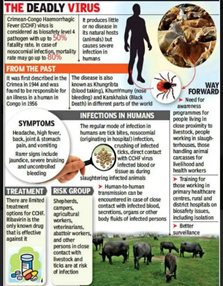Cases of Crimean Congo Haemorrhagic Fever (CCHF) were reported from the Gujarat and Maharashtra
- Posted By
10Pointer
- Categories
Science & Technology
- Published
10th Oct, 2020
-
- The Crimean-Congo haemorrhagic fever (CCHF) virus causes severe viral haemorrhagic fever outbreaks.
- CCHF outbreaks have a case fatality rate of up to 40%.
- The virus is primarily transmitted to people from ticks and livestock animals. Human-to-human transmission can occur resulting from close contact with the blood, secretions, organs or other bodily fluids of infected persons.
- CCHF is endemic in Africa, the Balkans, the Middle East and Asia, in countries south of the 50th parallel north.
- There is no vaccine available for either people or animals.
- Signs and symptoms
- The length of the incubation period depends on the mode of acquisition of the virus. Following infection by a tick bite, the incubation period is usually one to three days, with a maximum of nine days.
- The incubation period following contact with infected blood or tissues is usually five to six days, with a documented maximum of 13 days.
- Onset of symptoms is sudden, with fever, myalgia, (muscle ache), dizziness, neck pain and stiffness, backache, headache, sore eyes and photophobia (sensitivity to light).
- There may be nausea, vomiting, diarrhea, abdominal pain and sore throat early on, followed by sharp mood swings and confusion.
- After two to four days, the agitation may be replaced by sleepiness, depression and lassitude, and the abdominal pain may localize to the upper right quadrant, with detectable hepatomegaly (liver enlargement).

